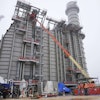
JUNEAU, Alaska (AP) — The U.S. Interior Department has issued a decision to limit roughly half the National Petroleum Reserve-Alaska to oil and gas leasing, rolling back a Trump-era policy criticized by conservationists that would have vastly expanded lands available for potential development.
The plan would prevent oil and gas development in areas considered important for sensitive bird populations and the Teshekpuk and Western Arctic caribou herds, the decision dated Monday states.
Alaska's U.S. senators criticized the decision as shortsighted and as closing off millions of acres to potential oil and gas activity. Some conservation groups said they saw as positive the new decision but want more action from the Biden administration in moving away from fossil fuels.
The decision was signed by an Interior Department official and released following a recent visit to the state by Interior Secretary Deb Haaland.
The decision calls for management consistent with plans adopted during the Obama administration, while “including certain more protective lease stipulations and operating procedures for threatened and endangered species” from the Trump-era plan, the U.S. Bureau of Land Management said.
The decision is in line with a position the land management agency earlier this year said it favored. The agency falls under the Interior Department.
The reserve covers about 36,000 square miles (92,000 square kilometers) on Alaska's North Slope. Under the decision, about 18,000 square miles (48,000 square kilometers) would be open to oil and gas leasing. That includes some lands closest to existing leases centered on the Greater Mooses Tooth and Bear Tooth units and the Umiat field, the decision states.
New infrastructure would be prohibited on about 13,000 square miles (34,000 square kilometers), it states.
Plans advanced during the Trump administration would have allowed for oil and gas leasing on about 29,000 square miles (75,000 square kilometers).
Alaska U.S. Sen. Lisa Murkowski called the new decision a bad one.
"It is simply shocking that the Biden administration can look at the world and decide that Alaska is where ‘keep it in the ground’ should apply,” Murkowski said in a statement.
President Joe Biden at the start of his term last year directed officials to review and respond to agency actions under the prior administration that were deemed in conflict with policies Biden set out around the environment, public health and climate change. The decision is an extension of that process.
Conservationists had argued the plan advanced during the Trump administration was too extensive. Kristen Miller, conservation director with the Alaska Wilderness League, said the new decision is “the right move in the near term.” But Miller said there's more to be done.
“World events have predictably led to industry lobbyists and the lawmakers they bankroll calling for new domestic oil and gas leasing and production, especially in Arctic Alaska, and in the name of ‘energy security,'" Miller said in a statement. “In reality, the answer to energy security does not lie beneath the thawing Arctic permafrost but in accelerating the shift to clean, renewable sources of power generation.”






















